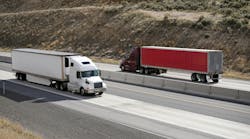Inflation pressure maintenance is the single most important variable in controlling tire performance. The amount of tire debris scattered along truck routes — the most visible evidence of what can go wrong when tires are not inflated properly — is an indication of how difficult it can be for fleets to implement appropriate inflation maintenance procedures. Checking pressures frequently is awkward and time consuming if done right. It can take up to 20 min. to measure and correct tire pressures on a typical 18-wheeler. The task is complicated even further when hot vs. cold tire pressures and air-gauge calibrations are factored in. In addition, coordinating vehicle downtime with available technician time adds expense and inefficiency.
Tire engineers agree that optimum resistance to irregular wear, best overall wear and best fuel efficiency are achieved by matching inflation pressure to the service conditions at hand, and that a single pressure, while practical, is a compromise. Target inflations are usually chosen as a compromise for the variety of running conditions between empty and fully loaded, rather than a correct value for a particular service condition.
Many logging trucks already use complex inflation adjustment systems that drop pressures when running slow on unpaved forest access roads, and inflate to higher pressures for high-speed OTR segments. Benefits include better traction and less road damage while off-road, and good casing durability, fuel economy and treadwear while running on pavement.
Although these systems take the impact of speed and load on tire performance into account, they rely on user-programmed pressure values and are not linked to real-time onboard sensors. Most are also susceptible to driver reprogramming, and require considerable time to adjust inflation pressures between settings that typically vary by 40 psi or more.
Simplified inflation maintenance systems that source air from the existing trailer air supply are available as options on many trailers, but these also use pre-selected target inflations, rather than real-time-sensed inflation needs. Matching pressures in dual-tire assemblies should no longer be a worry with these systems.
Applications most likely to benefit include the tight wheelhouse enclosures on dropdeck vans and auto transporters, as well as larger tires like wide-base singles.
Load and speed are the primary variables worthy of monitoring to determine optimum real-time tire inflation pressure, with ambient-temperature sensing a fine-tuning extra. It's also important to equip inflation maintenance systems with some method of alerting drivers or maintenance personnel when a tire is using more than a nominal amount of make-up air, as running with a slow air leak can lead to casing deterioration.
Since speed and ambient temperature are already sensed on many vehicles, and onboard scales are commonly found on logging trucks, it should be feasible to develop a method for using real-time sensing to optimize inflation pressures on truck tires.
Technologies developed to protect expensive truck components — such as engine diagnostics and shutdown systems to prevent failure in the event of critical fluid or fluid pressure loss — use reliable sensing and electronic signal communication systems that were neither widely available nor fully trusted a decade ago.
It's time to bring this technology to tires. The payback of lower tire costs per mile and enhanced highway safety could be considerable. Smart tires may be on the horizon and, like the people whose products they transport, some may be smarter than others.


